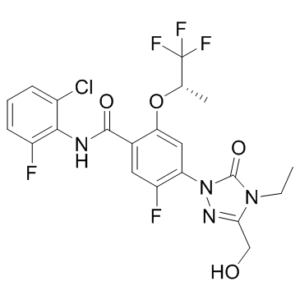BAY-2402234
This product is for research use only, not for human use. We do not sell to patients.

For small sizes, please check our retail website as below: www.invivochem.com
| Size | Price | Stock |
|---|---|---|
| 250mg | $2500 | Check With Us |
| 500mg | $4200 | Check With Us |
| 1g | $6300 | Check With Us |
Cat #: V4172 CAS #: 2225819-06-5 Purity ≥ 98%
Description: BAY-2402234 is a novel, potent/low-nanomolar and selective inhibitor of dihydroorotate dehydrogenase (DHODH) that has the potential for the treatment of myeloid malignancies.
Top Publications Citing Invivochem Products
Publications Citing InvivoChem Products
Product Promise

- Physicochemical and Storage Information
- Protocol
- Related Biological Data
- Stock Solution Preparation
- Quality Control Documentation
| Molecular Weight (MW) | 520.84 |
|---|---|
| Molecular Formula | C21H18ClF5N4O4 |
| CAS No. | 2225819-06-5 |
| Storage | -20℃ for 3 years in powder formr |
| -80℃ for 2 years in solvent | |
| SMILES Code | FC1=C(NC(C2=CC(F)=C(N3N=C(CO)N(CC)C3=O)C=C2O[C@@H](C)C(F)(F)F)=O)C(Cl)=CC=C1 |
| Synonyms | BAY-2402234; BAY 2402234; BAY2402234; Orludodstat; Orludodstatum; |
| Protocol | In Vitro | BAY-2402234 is a selective low-nanomolar inhibitor of human DHODH enzymatic activity. In vitro, it potently inhibits proliferation of AML cell lines in the sub-nanomolar to low-nanomolar range. BAY-2402234 induces differentiation of AML cell lines also in a sub-nanomolar to low-nanomolar range, demonstrating the anticipated mode of action in cellular mechanistic assays. |
|---|---|---|
| In Vivo | BAY-2402234 exhibits strong in vivo anti-tumor efficacy in monotherapy in several subcutaneous and disseminated AML xenografts as well as AML patient-derived xenograft (PDX) models. Target engagement of the novel DHODH inhibitor BAY-2402234 can be observed by increase of tumoral and plasma dihydroorotate levels after treatment with the inhibitor. Consistent with the in vitro data BAY-2402234 induces AML differentiation in vivo as detected by upregulation of differentiation cell surface markers in xenograft and PDX models after treatment with the inhibitor. Furthermore, differentiation-associated transcriptomic changes are evident following a single administration of BAY-2402234 in vivo. |
These protocols are for reference only. InvivoChem does not
independently validate these methods.
| Solvent volume to be added | Mass (the weight of a compound) | |||
|---|---|---|---|---|
| Mother liquor concentration | 1mg | 5mg | 10mg | 20mg |
| 1mM | 1.9200 mL | 9.5999 mL | 19.1998 mL | 38.3995 mL |
| 5mM | 0.3840 mL | 1.9200 mL | 3.8400 mL | 7.6799 mL |
| 10mM | 0.1920 mL | 0.9600 mL | 1.9200 mL | 3.8400 mL |
| 20mM | 0.0960 mL | 0.4800 mL | 0.9600 mL | 1.9200 mL |
The molarity calculator equation
Mass(g) = Concentration(mol/L) × Volume(L) × Molecular Weight(g/mol)
Mass
=
Concentration
×
Volume
×
Molecular Weight*
The dilution calculator equation
Concentration(start)
×
Volume(start)
=
Concentration(final)
×
Volume(final)
This equation is commonly abbreviated as: C1 V1 = C2 V2
Concentration(start)
C1
×
Volume(start)
V1
=
Concentration(final)
C2
×
Volume(final)
V2
Step One: Enter information below
Dosage mg/kg
Average weight of animals g
Dosing volume per animal µL
Number of animals
Step Two: Enter the in vivo formulation
%DMSO
+
%
+
%Tween 80
+
%ddH2O
Calculation Results:
Working concentration:
mg/ml;
Method for preparing DMSO master liquid:
mg
drug pre-dissolved in
µL
DMSO(Master liquid concentration
mg/mL)
,Please contact us first if the concentration exceeds the DMSO solubility of the batch of drug.
Method for preparing in vivo formulation:
Take
µL
DMSO master liquid, next add
µL
PEG300, mix and clarify, next add
µL
Tween 80,mix and clarify, next add
µL
ddH2O,mix and clarify.
Note:
- (1) Please be sure that the solution is clear before the addition of next solvent. Dissolution methods like vortex, ultrasound or warming and heat may be used to aid dissolving.
- (2) Be sure to add the solvent(s) in order.




































